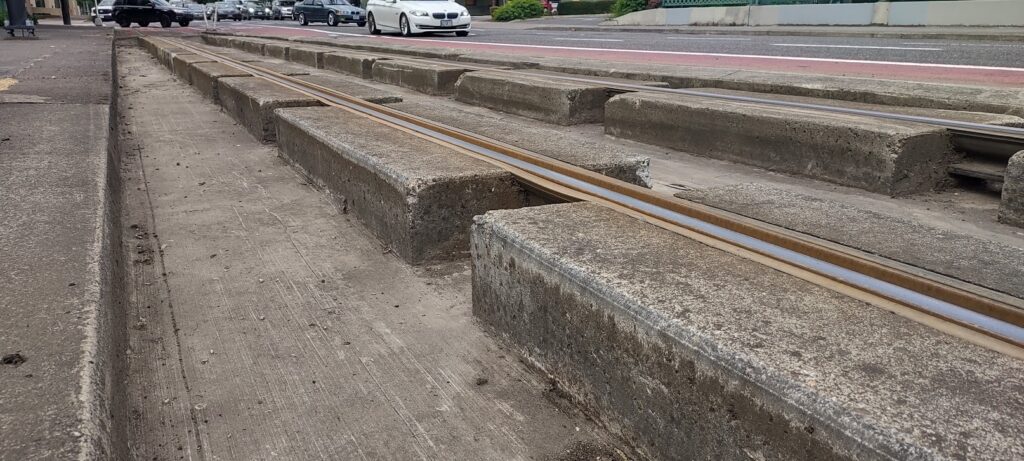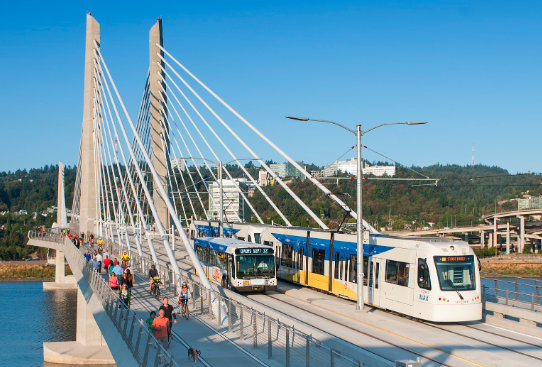ODOT isn’t giving buses the shoulder, it’s giving transit the finger.
IBR is planning a transitway for the new $7.5 billion interstate bridge that can’t be used by buses.
It’s sketching in a “bus on shoulder” option as an excuse to justify building an even wider highway crossing.
Meanwhile it plans to place light rail tracks on raised concrete blocks, rather than embedding rails in the road surface, so that the transit right of way can be used by both light rail trains and buses.
Direct Fixation: No buses allowed
Each of the bridge’s carrying Portland’s light rail and street car lines across the Willamette River has flush-mounted, recessed rails, that allow both trains and rubber-tired vehicles to use the same travel lanes. Even the original Interstate Bridge, built more than a century ago, had recessed rails for interurban trains. Flush mounted rails allow buses and light trains to use the same lanes.
Yet, IBR’s plan is to use embedded LRT track at only at intersections and “direct-fixation track throughout the rest of the program improvements.” As the Portland Mercury reported:
In their plans for the MAX light rail extension, IBR program leaders have indicated the train will travel across the bridge on direct fixation rails. Direct fixation rails are raised on blocks above the surface of a roadway, making it so non-rail vehicles can’t utilize the same road space. In comparison, the Broadway, Steel, and Tilikum Crossing bridges in Portland all have embedded railways, allowing for increased transit capacity on the same roadway.
Only where the light rail line crosses or intersects with a roadway will they use embedded tracks—so as not to inconvenience cars.
“Direct fixation” is techno-speak for rails raised up on blocks above the surface of the roadway. In contrast to embedded or flush-mounted rails, the “direct fixation” rails create a roadway that can’t be navigated by non-rail vehicles, in this case, specifically, buses. It’s marginally cheaper to do direct fixation, but it means that the roadway then can’t be used by buses (or emergency vehicles). A short section of Portland’s streetcar crosses over Interstate 84 on a bridge that has rails mounted in raised concrete blocks:

Every other light rail and streetcar bridge in Portland has surface-mounted rails that allow rail vehicles and rubber tire vehicles to use the same right of way.
The proposed IBR will have about one train every ten or fifteen minutes in each direction. There’s no reason why buses can’t run on the same exclusive transit right of way as the light rail trains. The bus-on-shoulder option requires buses to run in mixed traffic, and for all entering traffic to cross the bus-shoulder lane to reach the auto travel lanes.
This is a reprise of a tactic that the “Power Broker” used in the 1930s to block transit service to suburban parks and homes. Just as Robert Moses intentionally designed all of the overpasses on the Long Island’s South Shore Parkway to be too low to be cleared by buses, this one design decision is designed specifically to thwart optimal use of this roadway for transit.
Bucolic sure, but built so no buses will ever travel here. Just like the transitway on the Interstate Bridge Replacement.
As Robert Caro wrote in his biography of Moses, a New York planner observed:
In practice, no practical bus operator would run his buses on any road on which the clearance at the curb wasn’t at least fourteen feet . . . the old son of a gun had made sure that buses would never be able to use this godamned parkways. (The Power Broker, page 952).
Bus-on-shoulder
IBR advertises “bus-on-shoulder” as a key part of its high capacity transit plans for the $7..5 billion project.
In reality, though, bus-on-shoulder is just an excuse to build an extra wide bridge. Once the bridge is built, ODOT and WSDOT can easily re-stripe the bridge to include more travel lanes. Elsewhere, ODOT and other highway agencies have used the excuse that they aren’t expanding the footprint of the roadway (or acquiring added right-of-way to argue that adding a lane via painting new lines qualifies for a categorial exclusion from environmental review—so no one ever looks at the added driving and pollution caused by widening the roadway.
It then becomes the justification for widening the roadway deck of the bridge, ostensibly to provide for “bus on shoulder” but in reality, to rationalize building a roadway that with a few hours work by a paint truck, can be re-striped to the full twelve-lane freeway ODOT and WSDOT have always wanted to build.
Instead of bus-on-shoulder, IBR could much more readily build “bus-on-shared-transitway” with embedded track, that would give buses an exclusive lane with no conflicts with road traffic. On a double-decker bridge design, the transitway would be 35 feet lower than the highway deck (and its shoulder), meaning that buses would have less of a grade to climb, and would perform better. And the last new bridge completed in the Portland area, the Tillikum Crossing, has exactly this technology which allows both buses and light rail vehicles to use the same right of way.




